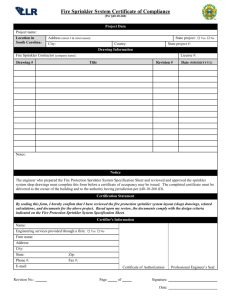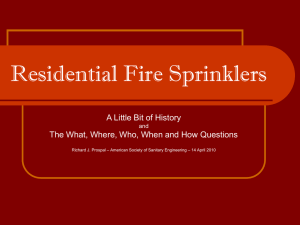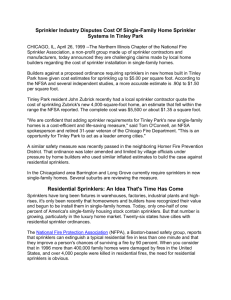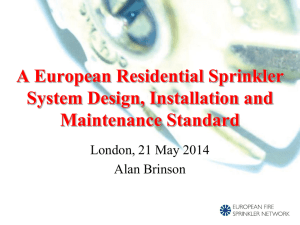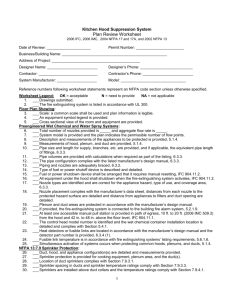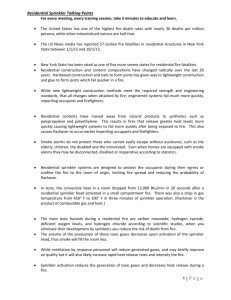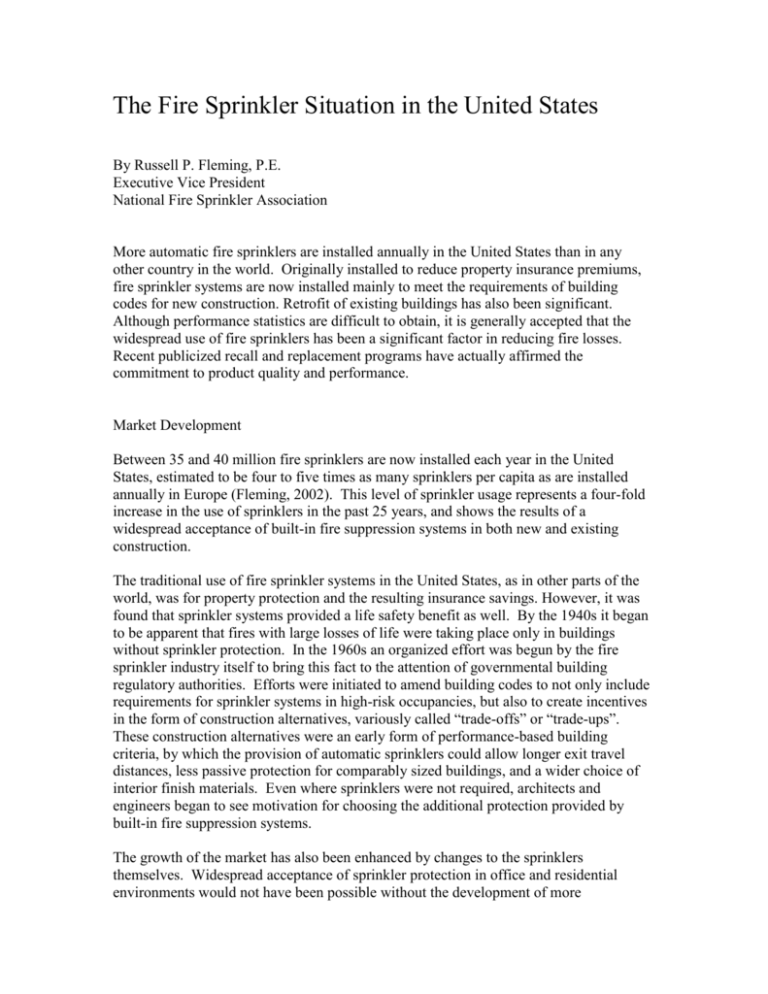
The Fire Sprinkler Situation in the United States
By Russell P. Fleming, P.E.
Executive Vice President
National Fire Sprinkler Association
More automatic fire sprinklers are installed annually in the United States than in any
other country in the world. Originally installed to reduce property insurance premiums,
fire sprinkler systems are now installed mainly to meet the requirements of building
codes for new construction. Retrofit of existing buildings has also been significant.
Although performance statistics are difficult to obtain, it is generally accepted that the
widespread use of fire sprinklers has been a significant factor in reducing fire losses.
Recent publicized recall and replacement programs have actually affirmed the
commitment to product quality and performance.
Market Development
Between 35 and 40 million fire sprinklers are now installed each year in the United
States, estimated to be four to five times as many sprinklers per capita as are installed
annually in Europe (Fleming, 2002). This level of sprinkler usage represents a four-fold
increase in the use of sprinklers in the past 25 years, and shows the results of a
widespread acceptance of built-in fire suppression systems in both new and existing
construction.
The traditional use of fire sprinkler systems in the United States, as in other parts of the
world, was for property protection and the resulting insurance savings. However, it was
found that sprinkler systems provided a life safety benefit as well. By the 1940s it began
to be apparent that fires with large losses of life were taking place only in buildings
without sprinkler protection. In the 1960s an organized effort was begun by the fire
sprinkler industry itself to bring this fact to the attention of governmental building
regulatory authorities. Efforts were initiated to amend building codes to not only include
requirements for sprinkler systems in high-risk occupancies, but also to create incentives
in the form of construction alternatives, variously called “trade-offs” or “trade-ups”.
These construction alternatives were an early form of performance-based building
criteria, by which the provision of automatic sprinklers could allow longer exit travel
distances, less passive protection for comparably sized buildings, and a wider choice of
interior finish materials. Even where sprinklers were not required, architects and
engineers began to see motivation for choosing the additional protection provided by
built-in fire suppression systems.
The growth of the market has also been enhanced by changes to the sprinklers
themselves. Widespread acceptance of sprinkler protection in office and residential
environments would not have been possible without the development of more
aesthetically appealing sprinklers. The changes in appearance have been accompanied by
changes in system installation criteria and acceptable materials that have contributed to
more economical system installation, lowering the resistance to system installation.
Building Code Requirements
Building regulation in the United States is not a federal activity, but takes place at the
state and city level. The difficulty and expense of writing and maintaining a building
code has led state and city governments to adopt “model” building codes, sometimes
making local amendments. While the first model building code in the United States was
written by an insurance association in 1905, the model building codes with wide
adoptions have been written mainly by associations of building officials. Today there are
two model building codes available for adoption in the United States. The International
Building Code is written by the International Code Council (ICC), a joint effort of three
longstanding building official associations. The National Fire Protection Association
(NFPA), internationally known for the development of codes and standards through a
consensus process, has also recently developed a model building code, known as NFPA
5000. Working with partners, NFPA has developed a complete package of codes for the
built environment, now called the C3 code set (Comprehensive Consensus Codes).
With regard to sprinkler system requirements and incentives, the two codes are very
similar. Typical thresholds above which sprinkler systems are required in the IBC
include:
Mercantile: Over 12,000 ft2 (1115 m2) in one fire area, or over 24,000 ft2 (2230
m2) in combined fire area on all floors, or more than 3 stories in height
High-Rise: All buildings over 55 ft (16.8 m) in height
Residential Apartments: All buildings except townhouses built as attached singlefamily dwellings
Typical thresholds above which sprinkler systems are required in NFPA 5000 include:
Mercantile: Over 12,000 ft2 (1115 m2) in gross fire area or three or more stories in
height
High-Rise: All buildings over 75 ft (22.9 m) in height
Residential Apartments: All buildings except those in which each unit has
individual exit discharge to the street
Reductions in fire resistance ratings and other incentives given in consideration of
sprinkler protection represent a basic form of performance based fire protection
2
engineering built into the prescriptive code itself in the form of alternatives. In the
aftermath of the September 2001 collapse of the World Trade Center buildings, some
have questioned whether automatic fire suppression should be given credit against the
passive protection of structural fireproofing. But it should be pointed out that the World
Trade Center was not originally built with sprinkler protection, and therefore no
reduction in fire resistance was granted on the basis of the sprinkler protection. Built in
the early 1970s, the World Trade Center towers were retrofitted with sprinkler protection
in the 1980’s. The Federal Emergency Management Agency report on the World Trade
Center collapse indicates that both the automatic sprinkler system and the ability to
conduct manual firefighting activities with the use of the standpipe system were disabled
by the initial impacts of the hijacked commercial aircraft.
The complete set of sprinkler requirements, as well as the incentives, for one of the two
available U.S. model building codes, the NFPA 5000 Code, can be viewed free of charge
on the internet at www.nfpa.org.
Retrofit Programs
Along with sprinkler system installation in new construction, there have been several
types of occupancies for which retrofit of sprinklers in existing buildings has been
accomplished either voluntarily or by legislative mandate. As might be expected,
relatively high-risk occupancies have experienced the most retrofit activity.
Nursing homes were the first major group of facilities to see requirements for sprinklers
in existing facilities, back in the 1970’s. Due to federal standards for safety based on the
provisions of the NFPA 101 Life Safety Code, almost all licensed nursing homes in the
United States are provided with sprinkler protection today.
Hotels were the major retrofit market in the 1980’s. Large chains like the Marriott,
Sheraton and Hilton not only embraced sprinkler protection for new construction, but
also set corporate standards that called for sprinkler protection of almost all their existing
facilities. This effort was enhanced by the development of new technology for the
sprinkler industry, like sidewall sprinklers that could protect guest rooms without the
need for piping in the floor-ceiling slab, and the permissible use of cleaner piping
materials, in many cases allowing a guest room to be retrofitted with sprinklers and
rented that same evening. By 1988, a survey conducted by the American Hotel and
Motel Association (AHMA, 1988) revealed that guest rooms were sprinklered in 45% of
all hotels and motels. Fire statistics, which tend to under-report sprinkler usage due to the
number of small fires successfully extinguished, indicated in 1998 (Rohr, 2001) that only
40% of the fires in hotel and motels took place in sprinklered facilities, even after 10
additional years of sprinkler retrofits and the construction of thousands of fully
sprinklered new hotels. The fact that the 1998 statistics indicated that 77% of the fires
reported in high-rise hotels and motels were in sprinklered properties, makes it likely that
well over 90% of such properties are now protected with sprinklers.
3
In the 1990’s several cities and states enacted legislation to require retrofit of high-rise
office buildings. The City of Philadelphia led the way, based on its experience with the
One Meridian Plaza fire in 1991, in which firefighters were told to leave the building.
The fire burned through 5 stories until it encountered a floor that had been equipped with
fire sprinkler protection, and where 7 sprinklers activated to stop the spread of the fire
upward. Similar high-rise retrofit laws have been enacted in New York City, Boston,
Massachusetts, and Louisville, Kentucky.
As we move into the 21st century, university housing has become the focal point for
sprinkler retrofit. Dormitories as well as fraternity and sorority houses have been
equipped during summer breaks by hundreds of the leading colleges and universities. In
most cases this has been done voluntarily; in some the threat of state action has been
motivating factor. Several states have enacted low-interest loan programs to assist the
universities with financing the cost of system installation.
Information on more than 50 individual retrofit programs affecting various occupancies
in cities and states in the United States can be found on the website of the National Fire
Sprinkler Association at www.nfsa.org.
Effect of Sprinkler Usage
As mentioned above, because U.S. fire statistics capture only the sprinkler usage in fires
reported to the fire department, it is likely that the actual usage of sprinklers, and
therefore the reduction in losses due to sprinklers, is greater than those reported. Many
small fires extinguished by the sprinkler system go unreported.
Nevertheless, based on information from the National Fire Incident Reporting System
(NFIRS) for the period of 1989 through 1998, the Fire Analysis and Research Division of
the NFPA reports an ability of sprinkler systems to reduce fire deaths and property loss
by a factor of one-half to two-thirds (Rohr, 2001).
For specific types of occupancies, the reduction in the average number of civilian deaths
due to the presence of sprinkler protection is reported to be 60% for manufacturing
properties, 74% for stores and offices, 75% for selected health care occupancies, and 91%
for hotels and motels. Property loss reductions average 53% for stores and offices, 64%
for manufacturing properties, 66% for selected health care occupancies, and 70% for
public assembly occupancies.
In general, NFPA estimates the ability of sprinklers to reduce fire deaths per thousand in
residential occupancies to be on the order of 74%. This is significant since 85% of the
fire deaths in the U.S. take place in residential occupancies, and residential occupancies
are the least likely to have sprinkler protection. Fire statistics for 1998 indicate only
7.9% of apartment fires were in sprinklered occupancies, and only 0.7% of fires in one
and two-family dwellings. So in spite of the well-publicized successes of the residential
4
sprinkler programs of communities like Scottsdale, Arizona (Ford, 1997) and Prince
George’s County, Maryland (Siarnicki, 2001), there is much work still to be done.
Product Recalls and Replacement Programs
There has also been a great deal of publicity in the past few years in the United States
relative to the performance of the sprinkler devices themselves. As discussed earlier,
statistics relative to sprinkler system reliability traditionally focused on the performance
of the systems, and the possibility of inadequate design discharge or closed valves. Little
attention was given to the possibility that individual sprinklers would not operate as
intended because it was considered almost impossible due to the simple nature of fusing
of a solder link or expansion of the liquid to shatter a glass bulb. Sprinkler devices
gained such a reputation of reliability that in 1977 the NFPA document for system
maintenance, then NFPA 13A, was changed to eliminate the suggestion that sprinklers be
replaced after 50 years of service. Instead, a sampling program was initiated to check
that sprinklers were still capable of proper operation after 50 years of service. Mandatory
replacement was only suggested for sprinklers manufactured prior to 1920.
This changed in the 1990s, beginning with an announcement in 1990 by Star Sprinkler
that certain models of dry sprinklers produced between 1961 and 1981 might not operate
properly at low pressures due to an internal corrosion problem. The company
recommended replacement of those models. In 1995 two incidents of non-operation of
sprinklers in fires took place, one in a government medical center in New York, and the
other in a Marriott hotel property in Michigan. This led to an investigation of the Central
“Omega” sprinklers that ultimately involved a 1998 recall of up to 9 million sprinklers in
cooperation with the U.S. Consumer Product Safety Commission (CPSC).
It was recognized that the Omega had been a “breakthrough” sprinkler, combining new
fast response technology with the new aesthetics needed to address new markets. In
retrospect, the product issues associated with the Omega may well be the natural
consequence of a major shift in technology. The Omega incident either directly or
indirectly led to a number of initiatives aimed at ensuring sprinklers would retain their
historical reliability while also meeting the new demands of performance and aesthetics.
These included a number of new tests applied by Underwriters Laboratories:
Materials compatibility check for residual hydrocarbons and antifreeze solutions
(effective 8 October, 1998)
Ban on use of dynamic o-rings (effective 9 January, 2003)
Internal deposit loading test for dry sprinklers (effective 9 January, 2003)
Direct impact tests for glass bulb sprinklers while in protective packaging
(tentatively effective July 2004)
Waterway clearance verification for dry sprinklers (tentatively effective January
2004)
Sealed atmosphere test for dry sprinklers (tentatively effective July 2004)
5
Dezincification test for copper alloy sprinkler parts normally exposed to system
water with high (over 15%) zinc content (effective 9 January, 2003)
Perhaps the most notable result of the new scrutiny applied to sprinkler performance was
the announcement by Tyco Fire Products in 2001 of a “voluntary replacement program”
involving up to 35 million Central, Gem and Star sprinklers manufactured using o-rings.
This included up to 2 million dry sprinklers manufactured from the 1970’s through 2001
and 33 million “wet” sprinklers manufactured between 1989 and 2000 (information
available at www.sprinklerreplacement.com).
To some, these announcements and the involvement of the CPSC in the sprinkler industry
has been viewed as an unfortunate state of affairs. However, these events can also be
viewed as the ultimate affirmation of the important role automatic sprinklers now play in
fire protection, and the commitment of the United States government to preserve that
role. CPSC effectively established a standard of performance to which no other fire
safety device has ever been held, and has given notice that it will continue to demand the
full (99+%) reliability that has been established by sprinklers over the past century. The
Tyco voluntary replacement program is a dramatic example of a company, and an
industry, standing behind its products.
The new scrutiny applied to sprinklers can also be credited with some other significant
changes in the industry. We have seen the introduction of the Sprinkler Identification
Number, by which a one or two-character manufacturer code and three or four-digit
number allows every model with a difference in orifice, sensitivity or distribution
characteristics to be readily identified (effective 1 January, 2001). We have also had a
major recalibration of the room fire test used to evaluate residential sprinklers, to ensure
consistency and therefore to ensure performance in residential fires (effective 12 July,
2002). The new residential sprinkler listings can be viewed at www.ul.com in the
category of “regulators” and subcategory of “sprinklers”.
The record of automatic fire sprinklers is still remarkable. It remains a simple fact that
there has never been a multiple death of building occupants from a fire developing in a
building protected by an automatic fire sprinkler system properly designed, installed, and
maintained in accordance with recognized standards. This is clear evidence that the fire
sprinkler concept works.
The Future
It is likely that the use of fire sprinklers will continue to grow in the United States. As the
new model building codes are implemented, sprinklers will be used to a greater extent
than ever before. The biggest potential for growth remains in the residential market, with
1.5 million new homes constructed every year. Just last month the International
Association of Fire Chiefs released its new strategic plan for 2003-2004 (IAFC, 2002).
Part of that plan calls for fire chiefs to “actively support the use of residential fire
sprinklers and smoke alarms.”
6
We are hopeful that other parts of the world will join the United States in the movement
toward widespread acceptance of the fire sprinkler concept. The International Fire
Sprinkler Association has this as its goal (refer to www.sprinklerworld.org), and progress
is being made toward that goal through the formation of national and regional
organizations focused on promoting the fully sprinklered community. For example, the
newly-formed European Fire Sprinkler Network, in which the sprinkler industry and the
fire service can work together to promote fire sprinkler protection, has an enormous
potential to increase the use of automatic fire sprinkler systems on the European
continent, saving countless lives and protecting property with a proven technology.
References:
AHMA, “Fire Protection in the Lodging Industry,” American Hotel and Motel Association, Washington,
DC, June, 1988.
Fleming, Russell P., “World Sprinkler Market Tops 70 Million”, International SprinklerScene,
International Fire Sprinkler Association, April 2002.
Ford, Jim, “Automatic Sprinklers – a 10 Year Study – A detailed history of the effects of the automatic
sprinkler code in Scottsdale, Arizona,” Published by the Home Figure Sprinkler Coalition, NFPA, Quincy,
MA, 1997.
Rohr, Kimberly D., “U.S. Experience With Sprinklers,” National Fire Protection Association, September
2001.
Siarnicki, Ronald J., “Residential Sprinklers: One community’s experience twelve years after mandatory
implementation”, report submitted to National Fire Academy, January 2001.
IAFC, “A Time to Lead - 2003-2004 Strategic Plan,” International Association of Fire Chiefs, Washington,
DC, November 5, 2002
International Building Code, 2003 Edition, International Code Council, Inc., International Conference of
Building Officials, Inc., Whittier, CA, 2003.
NFPA 5000 Building Construction and Safety Code, National Fire Protection Association, Quincy, MA,
2003.
c. National Fire Sprinkler Association, 2002. All rights reserved.
7


